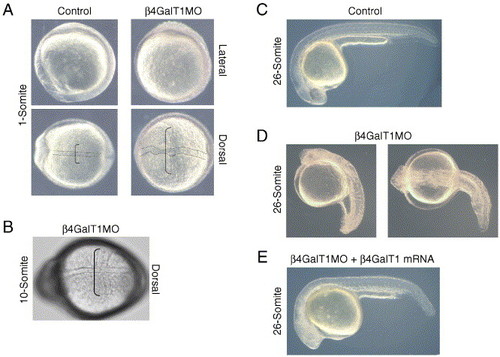Fig. 3
- ID
- ZDB-FIG-061012-2
- Publication
- Machingo et al., 2006 - A beta1,4-galactosyltransferase is required for convergent extension movements in zebrafish
- Other Figures
- All Figure Page
- Back to All Figure Page
|
Knockdown of β4GalT1 results in a complex patterning defect. (A) One-somite embryos injected with either control or β4GalT1 morpholino oligonucleotides. In β4GalT1MO embryos, the notochord shows an undulating phenotype (doted lines) and extensively elongated somites (brackets). (B) 10-somite stage embryo illustrating the laterally elongated somites (bracket). (C) 26-somite stage embryo injected with control morpholino oligonucleotides displays a wild-type phenotype. (D) 26-somite stage β4GalT1MO embryos have a complex phenotype, consisting of a truncated anterior–posterior axis, disorganization of the lateral mesoderm, and bending of the tail. (E) Embryos injected with β4GalT1MO2 and an EST encoding the putative catalytic domain of zebrafish β4GalT1 results in a “rescue” of the morphant phenotype. |
Reprinted from Developmental Biology, 297(2), Machingo, Q.J., Fritz, A., and Shur, B.D., A beta1,4-galactosyltransferase is required for convergent extension movements in zebrafish, 471-482, Copyright (2006) with permission from Elsevier. Full text @ Dev. Biol.

